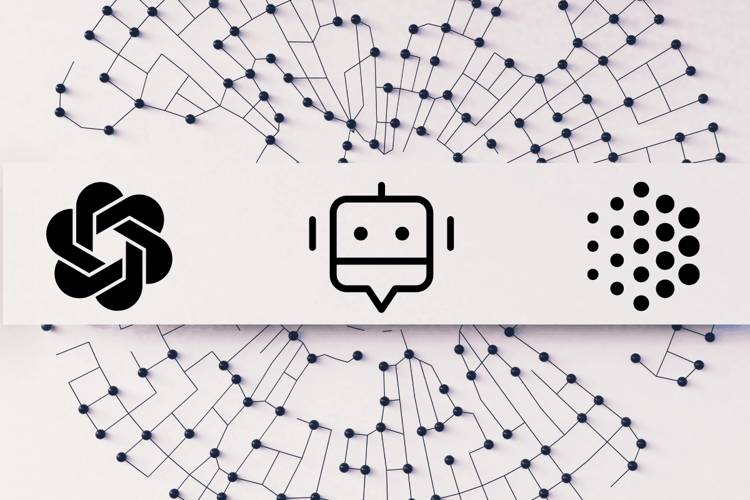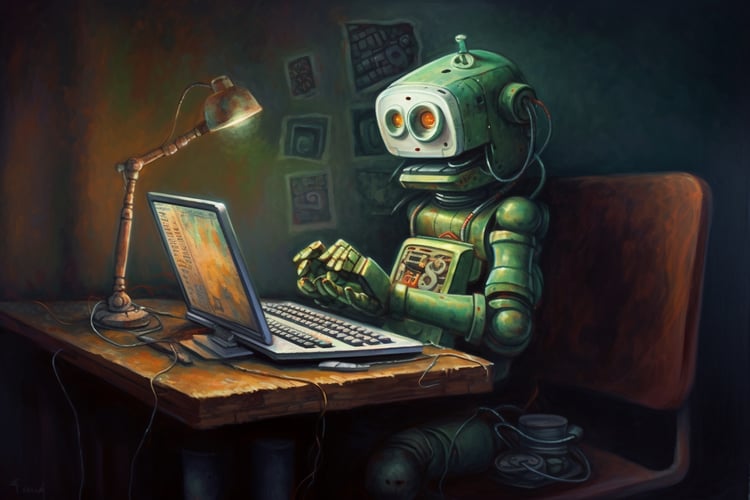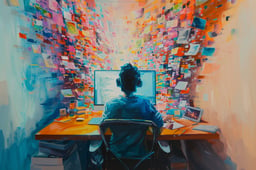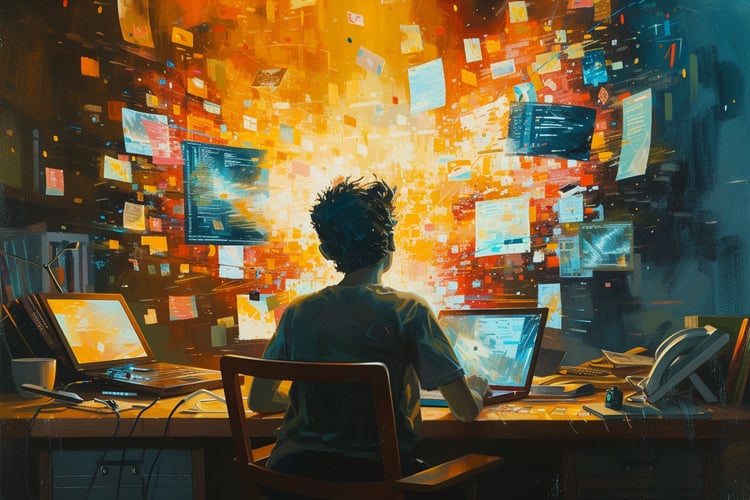DALL-E is a generative AI model developed by OpenAI, designed to generate images from text description prompts. Its uniqueness stems from its ability to combine language and visual processing. Simply put, you provide a textual description of an image, and DALL-E will generate it, even if the image is of a concept that doesn't exist in the real world. This innovative approach opens new possibilities for creative fields, communication, education, and more.
DALL-E Explained
DALL-E, first introduced in January 2021, is a variant of the language-processing model based on GPT-3, another significant development by OpenAI. The "DALL" in DALL-E pays tribute to the surrealist artist Salvador Dalí, while the "E" refers to Pixar's animated robot Wall-E. Its successor, DALL-E 2, was introduced in April 2022, designed to generate more photorealistic images at higher resolutions.
In September 2023, OpenAI announced DALL-E 3, a significant upgrade over its predecessors. DALL-E 3 brings advanced capabilities in understanding nuance and following complex prompts with greater accuracy. The model can generate more coherent and precise images, offering users better results with less prompt engineering. DALL-E 3 also integrates directly into ChatGPT, allowing users to refine prompts and adjust images effortlessly, treating ChatGPT as a "creative partner" for image generation.
At its core, DALL-E leverages a transformer neural network, initially based on the GPT-3 architecture but now further enhanced by the advancements in GPT-4o. The model is trained on vast amounts of text-image pair data and uses an optimization process to fine-tune its parameters. This optimization process is essentially a feedback loop where the model predicts an output, compares it to the actual output, calculates the error, and adjusts the model parameters to minimize this error. This is done using a method called backpropagation and an optimization algorithm such as stochastic gradient descent.
DALL-E models, including the latest iteration, learn patterns and relationships between textual descriptions and visual elements. For example, DALL-E learns to associate the word "dog" with its visual concept by repeatedly seeing images of dogs alongside the term. This ability extends to more complex associations, such as generating an image of "a two-story pink house shaped like a shoe" with a high degree of accuracy and detail in DALL-E 3.
Over time, DALL-E has developed an impressive ability to create entirely new images, even for surreal or previously unseen concepts. The combination of text and image data enables DALL-E to 'imagine' and produce images that are contextually relevant and creatively original, much like a human artist interpreting a textual description.
DALL-E 3's focus on precision, ease of use, and enhanced safety measures—such as preventing the generation of explicit or discriminatory content—expands its applicability across industries. Additionally, it avoids generating images that resemble public figures or closely mimic the distinct styles of living artists, addressing legal and ethical concerns around intellectual property.
Current applications of DALL-E range from generating unique artworks to enhancing visual communication. With DALL-E 3, educators can create detailed visual aids for abstract concepts, marketers can design custom imagery for campaigns, and designers can easily generate unique visuals based on specific descriptions, all with less manual intervention than in previous versions.
Examples of Real-World Use Cases of DALL-E
Some real-world use cases of DALL-E that demonstrate its potential in various industries include:
- Education. For teaching abstract concepts, DALL-E could be a game-changer. It can generate visual aids, helping students understand complex theories or events in history, like visualizing the Battle of Waterloo.
- Design. Designers could use DALL-E to generate custom artwork or initial drafts based on specific descriptions, significantly speeding up the creative process. For instance, an author could use it to generate illustrations for their book by providing descriptions of specific scenes.
- Marketing. DALL-E could be used to create unique, custom images for ad campaigns based on creative briefs. A marketing team could input specific descriptions of the product, mood, color palette, etc., and get custom graphics without needing to rely on stock photos or extensive graphic design work.
What are the Benefits of DALL-E?
- Efficiency. DALL-E can generate images from textual descriptions quickly and efficiently, saving time, costs and resources compared to traditional methods of image creation, such as manual graphic design or photography.
- Creativity. DALL-E can interpret and visualize abstract or complex concepts that might be difficult or time-consuming for human artists to render. This could potentially expand the boundaries of creativity and art.
- Customization. It can create highly customized visuals based on specific input descriptions. This could be particularly useful in fields like advertising, gaming, and design where unique, tailored visuals are often needed.
- Accessibility. DALL-E could democratize access to custom graphic design, potentially allowing small businesses, independent creators, and others who can't afford professional design services to create unique visual content.
What are the Challenges of DALL-E?
DALL-E, like other generative AI technologies, comes with challenges and concerns, for instance:
- Unpredictability. While DALL-E can generate images based on descriptions, the exact output is not predictable or fully controllable, which might be a challenge for applications that require precision and consistency.
- Intellectual property concerns. Since DALL-E generates images based on its training data, which includes a vast range of images from the internet, there may be concerns over copyright infringement if the generated images resemble copyrighted works too closely.
- Content moderation. DALL-E could potentially be used to generate inappropriate, offensive, or harmful images if not properly moderated. Controlling and moderating the content it generates to avoid such misuse is a significant challenge.
- Job displacement. The automation of content creation could potentially displace jobs in fields like graphic design and illustration. However, it could also open up new roles in overseeing and managing these AI systems.
DALL-E Alternatives
Although DALL-E remains one of the most popular AI image generators, there are now several alternatives that are also widely used. Two of the most prominent tools are Midjourney and Stable Diffusion.
Midjourney was developed by an independent research lab based in San Francisco. It's noted for its high-quality, well-structured, and detailed output. To access Midjourney, you’ll need a Discord account and an active subscription. Simply join the Midjourney Discord server, pick a plan, and use the /imagine command in one of the bot channels to start generating images. Midjourney does require a payment for image generation.
Open-source and initially trained on 2.3 billion images, Stable Diffusion is developed by researchers from the CompVis Group, Ludwig Maximilian University of Munich, StabilityAI, and RunwayML. Stable Diffusion is growing in popularity and has an active community involved in its ongoing evolution. It has both free and paid versions. See our tutorial on how to run Stable Diffusion to get started.
Here’s a comparison table of DALL-E 3 and its main competitors, Midjourney v6 and Stable Diffusion XL, based on the latest features and performance as of 2024.
| Feature/Aspect | DALL-E 3 | Midjourney v6 | Stable Diffusion XL |
|---|---|---|---|
| Ease of Use | Integrated with ChatGPT, easy for beginners. Limited fine-tuning due to ChatGPT filtering. | Requires Discord setup, more complex prompts, steeper learning curve. | Open-source but requires technical setup or cloud-based access, best for expert users. |
| Prompt Adherence | Excellent at following complex prompts accurately, ideal for multi-character scenes. | Handles simple prompts well but struggles with multiple subjects. | Good with complex prompts but less reliable for intricate, surreal elements. |
| Photorealism | Produces realistic images, though sometimes overly airbrushed. | Best at photorealism, highly detailed outputs. | Strong in photorealism, but tends to struggle with highly creative or surreal elements. |
| Artistic Styles | Can handle various styles, but not great at emulating specific artists. | More flexibility with artistic creativity, can create impressive artistic interpretations. | Best for custom styles, supports user-trained models and tools like ControlNet for precise control. |
| Customization | Limited customization, relies on ChatGPT’s filtering. | Highly customizable through advanced prompts and parameters. | Extremely customizable via third-party tools and open-source community, especially for experts. |
| Text Integration | Handles text integration well, generating readable and clean text in images. | Struggles with accurate text rendering. | Also performs well with text but can require fine-tuning. |
| Safety Features | Strong content moderation, filters out harmful or explicit images. | More lenient on generating content, including famous faces. | Minimal built-in moderation due to its open-source nature. |
| Access & Pricing | Free via Bing and ChatGPT (with limits), or $20/month for ChatGPT Plus. | Subscription-based, starting at $10/month on Discord. | Free if run locally, cloud access via services like DreamStudio at pay-per-use. |
| Best Use Cases | Ideal for users needing precise prompt adherence and quick results. | Best for users seeking creative freedom and photorealistic output. | Perfect for technically skilled users who want complete control over the output and style. |
How to Use DALL-E Effectively
I've been using Bing Image Creator, which is powered by DALL-E. I've realized that it's not as straightforward as just typing in what you want, as you need to understand prompts and learn some tricks to generate the desired image.
To get the most out of Dall-E, follow these tips:
Provide more details and be specific
It is vital to give a clear and detailed description of what you want, as this helps Dall-E better understand what to create. Use specific descriptions, such as "animated movie scene of someone overlooking a landscape of colorful hot air balloons floating above a canyon."
Experiment
Experiment with various text descriptions to discover the diverse range of images that Dall-E can produce. Don't hesitate to adjust the image to your liking by experimenting with colors, brightness, and other settings until you achieve your vision.
Focus on the vocabulary
When requesting an image from Dall-E, it's essential to use clear and precise language to describe what you want accurately. As Dall-E has been trained on various images, using the correct vocabulary and language is crucial to ensure the best results.
Image quality
When selecting writing prompts, consider using phrases like "highly detailed image" or "high-quality image" to ensure that the images you generate are detailed and of good quality.
Styling
You can image style to vector, painting, digital art, etc. Additionally, you can experiment with lighting, effects, range, and background to produce highly realistic images.
Community
Collaborate with others to discover their creations using DALL-E. Sharing experiences and outcomes can aid in learning from others and obtaining fresh concepts for generating impactful images with the model. I suggest joining Discord groups to learn from artists, such as this one.
Conclusion
Did you know that generative AI models have evolved into graphic designing tools? Now, you can easily replace the background of an image, add objects, make edits, and play around with the image using just a selection tool and a prompt. Gone are the days when you had to chase a graphic designer to create a logo for your company or design a post for you. These new tools, based on Dall-E, are revolutionizing the creator landscape.
Now is the perfect time to invest your time in learning how prompts work and become an expert prompt engineer.
Want to learn more about AI and machine learning? Check out the following resources:
FAQs
Can DALL-E create any image I describe?
DALL-E has been trained on a large variety of images and can generate a vast range of visuals. However, its ability to create an image depends on how well it understands and interprets the description.
Can DALL-E understand complex descriptions?
Yes, but the complexity of the description might affect the accuracy of the generated image. The clearer and simpler the description, the more likely the generated image will match your expectations.
Is DALL-E available for public use?
Yes, DALL-E is publicly available. It works via a credit based system, where each credit yields a single request. As a new user, you need to purchase a minimum of 115 credits to start using DALL-E.
Can DALL-E replace graphic designers?
While DALL-E can generate creative images, it doesn't replace the human creativity, thought process, and understanding that professional designers provide. It's a tool that could be used by designers, rather than a replacement.
What are the ethical concerns with DALL-E?
DALL-E's ethical concerns include the potential for misuse to generate harmful content, copyright issues, and the risk of future job displacement in the design industry.

As a certified data scientist, I am passionate about leveraging cutting-edge technology to create innovative machine learning applications. With a strong background in speech recognition, data analysis and reporting, MLOps, conversational AI, and NLP, I have honed my skills in developing intelligent systems that can make a real impact. In addition to my technical expertise, I am also a skilled communicator with a talent for distilling complex concepts into clear and concise language. As a result, I have become a sought-after blogger on data science, sharing my insights and experiences with a growing community of fellow data professionals. Currently, I am focusing on content creation and editing, working with large language models to develop powerful and engaging content that can help businesses and individuals alike make the most of their data.



